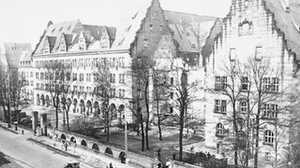The Start of the Cold War

On July 25, 1945, British Prime Minister Winston Churchill, Soviet Premier Joseph Stalin, and American President Harry Truman met in the German town of Potsdam to discuss the fate of Germany. The meeting underlined the differences between the Allied powers, and set the stage for a post-war "cold" war that would be waged in the coming decades between two global superpowers.
Communism vs. Capitalism
The United States and the Soviet Union each wanted their own economic and political systems to prevail in the areas their soldiers occupied -- not only in Germany, but also in Eastern Europe and in Asia. While at Potsdam, Truman heard that Americans had detonated the first successful atomic weapon in New Mexico. "We have discovered the most terrible bomb in the history of the world," the president would write in his diary. "It is certainly a good thing for the world that Hitler's crowd or Stalin's did not discover this atomic bomb," he added. "It seems to be the most terrible thing ever discovered, but it can be made the most useful."
Soviet Containment
At once, the balance of power shifted. Truman acted aggressively to secure territories from Soviet control. As U.S.-Soviet relations soured, the military divisions in Germany became de facto country boundaries, creating West and East Germany and the divided city of Berlin. In 1946, a Russian-based U.S. foreign service officer, George Kennan, sent Washington a message later known as the "long telegram," explaining Soviet hostility toward the West. According to Kennan, Stalin needed to believe in the triumph of communism over capitalism to legitimize his bloody dictatorship. He would do everything possible to undermine the major Western powers, but would not risk major war. Kennan's observations led to the American policy of Soviet containment, which was formalized in Truman Doctrine of March 12, 1947. Truman supplied aid to Greece and Turkey and set in motion a worldwide fight against Soviet Communism.
The Iron Curtain
For his part, Stalin began creating what Winston Churchill would call the "Iron Curtain." "From Stettin on the Baltic to Trieste on the Adriatic," said Churchill, "an iron curtain has descended across the continent. Behind that line lie all the capitals of the ancient states of central and Eastern Europe: Warsaw, Berlin, Prague, Vienna, Budapest, Belgrade, Bucharest and Sofia. From what I have seen of our Russian friends and allies during the war I am convinced that there is nothing they admire so much as strength and nothing for which they have less respect than military weakness." The Soviets sought to create a buffer zone between their country and Germany.
The Marshall Plan
The U.S.S.R. also demanded that Germany pay war reparations to rebuild the devastated Soviet infrastructure. In a different approach, the U.S. secretary of state, George Marshall, proposed a "European Recovery Program," known as the Marshall Plan, which allocated billions of dollars to European nations "to permit the emergence of political and social conditions in which institutions can exist." As the U.S. pumped billions of dollars into Europe, West Germany's economic recovery triggered a broader European recovery. The Soviets viewed this development as a capitalist plot to draw the nations of Eastern European into the American sphere of influence. Further evidence to the Soviets of cooperation to keep them out of Eastern Europe was the creation of the North Atlantic Treaty Organization (NATO), formed in 1949 "to safeguard the freedom, common heritage and civilization of their peoples founded on the principles of democracy, individual liberty, and the rule of law."
The U.S. in Europe
Four United States army divisions were stationed in Europe to serve as the nucleus of NATO forces. NATO signified that the United States could no longer remain isolated from European affairs. European affairs were conducted under an American "nuclear umbrella" that acted as a deterrent against any Soviet temptation to attack. One by one, Communist governments loyal to Moscow seized power in Poland, Hungary, Romania, and Bulgaria. Soviet Communism soon dominated Eastern Europe. The Cold War had begun.







